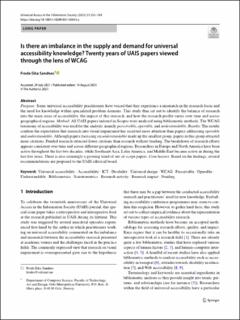| dc.contributor.author | Sandnes, Frode Eika | |
| dc.date.accessioned | 2022-08-09T08:57:59Z | |
| dc.date.available | 2022-08-09T08:57:59Z | |
| dc.date.created | 2022-06-04T10:49:40Z | |
| dc.date.issued | 2022-08-14 | |
| dc.identifier.citation | Universal Access in the Information Society. 2022, 21 333-349. | en_US |
| dc.identifier.issn | 1615-5289 | |
| dc.identifier.issn | 1615-5297 | |
| dc.identifier.uri | https://hdl.handle.net/11250/3010731 | |
| dc.description.abstract | Purpose: Some universal accessibility practitioners have voiced that they experience a mismatch in the research focus and the need for knowledge within specialized problem domains. This study thus set out to identify the balance of research into the main areas of accessibility, the impact of this research, and how the research profile varies over time and across geographical regions.
Method: All UAIS papers indexed in Scopus were analysed using bibliometric methods. The WCAG taxonomy of accessibility was used for the analysis, namely perceivable, operable, and understandable.
Results: The results confirm the expectation that research into visual impairment has received more attention than papers addressing operable and understandable. Although papers focussing on understandable made up the smallest group, papers in this group attracted more citations. Funded research attracted fewer citations than research without funding. The breakdown of research efforts appears consistent over time and across different geographical regions. Researchers in Europe and North America have been active throughout the last two decades, while Southeast Asia, Latin America, and Middle East became active in during the last five years. There is also seemingly a growing trend of out-of-scope papers.
Conclusions: Based on the findings, several recommendations are proposed to the UAIS editorial board. | en_US |
| dc.description.sponsorship | Open access funding provided by OsloMet - Oslo Metropolitan University | en_US |
| dc.language.iso | eng | en_US |
| dc.publisher | Springer | en_US |
| dc.relation.ispartofseries | Universal Access in the Information Society;21 (2022) | |
| dc.rights | Navngivelse 4.0 Internasjonal | * |
| dc.rights.uri | http://creativecommons.org/licenses/by/4.0/deed.no | * |
| dc.subject | Universal accessibility | en_US |
| dc.subject | Accessibility | en_US |
| dc.subject | ICT | en_US |
| dc.subject | Disabilities | en_US |
| dc.subject | Universal design | en_US |
| dc.subject | WCAG | en_US |
| dc.subject | Operability | en_US |
| dc.subject | Bibliometrics | en_US |
| dc.title | Is there an imbalance in the supply and demand for universal accessibility knowledge? Twenty years of UAIS papers viewed through the lens of WCAG | en_US |
| dc.type | Peer reviewed | en_US |
| dc.type | Journal article | en_US |
| dc.description.version | publishedVersion | en_US |
| dc.rights.holder | © The Author(s) 2021 | en_US |
| cristin.ispublished | true | |
| cristin.fulltext | original | |
| cristin.qualitycode | 1 | |
| dc.identifier.doi | https://doi.org/10.1007/s10209-021-00834-y | |
| dc.identifier.cristin | 2029487 | |
| dc.source.journal | Universal Access in the Information Society | en_US |
| dc.source.volume | 21 | en_US |
| dc.source.issue | 21 | en_US |
| dc.source.pagenumber | 333-349 | en_US |

